
Paramotor Communication
I fly paramotors with friends. And even if I did not I sometimes fly near airports. Having a good way to communicate is important. Well, by voice... you can always wave or wiggle your legs; it is not the same. You need to be able to talk: "Independence Traffic, ultralight activity, two miles north", or "Watch those power lines!" or "Hey, let's go chase that kid on the motorcycle!".
TL;DR
Here is your Too-Long-Didn't-Read summary:
Fly with at least a phone. If you get into trouble you will need to call help. Better yet, also carry a radio. Phone service is not available in rural areas and a radio is a great alternative. Chatting with other pilots in your gaggle is easiest with mesh intercom but radios have better range.
Several combinations of connecting a phone AND a Bluetooth radio to a Bluetooth headset were tested. The results are shown in this table (+ means it connected well, - means it had problems, space means it would not connect, ? means I am still testing):
| Generic Headset | Cardo Spirit | Cardo Neo | Sena 60S | |
|---|---|---|---|---|
| Phone | + | + | ? | + |
| Icom A16B | + | + | ? | - |
| Icom A25N | + | + | ? | - |
| Beofeng UV5mini | ? | ? | ? | ? |
| TIDRadio H3+ | - | - | ? | - |
| BT Adapter #1 | ? | + | ? | ? |
| BT Adapter #2 | + | + | ? | |
| BT Adapter #3 | ? | ? | ? | ? |
- A Generic Headset (SkullCandy Hesh 2) was used as a baseline.
- The Spirit is an old entry level Cardo model.
- The Neo is a newer Cardo model with their latest Mesh intercom.
- The 60S is the flagship Sena model with their latest Mesh intercom.
- The Phone is any number of current Android/IPhone models.
- All of the radios and adapters have internal Bluetooth.
Avoid the Sena 60s (unless your friends all have a Sena 60S AND you never plan on using a radio). It is too expensive, does not connect to radios, their Wave app is buggy, and their mesh distance is not as good as advertised.
If you never plan on using a Mesh intercom (which only works when everybody has the exact same Mesh type), then go for the cheapest basic Bluetooth headset. Even the most basic will connect to a phone and a radio simultaneously. The Cardo Spirit works very well.
Only choose an aviation radio (Icom A16B, Icom, A25N, etc.) if you need to talk with ATC or other aircraft. Otherwise, a non-aviation radio will not only communicate on Ham/GMRS frequencies (more people listening, better in an emergency, better for chatting) but can listen to aviation frequencies (which helps you avoid traffic). Non-aviation radios are actively being upgraded and improved. Aviation radios have a tendency to be antiquated, problematic, and expensive.
- Paramotor Communication
- TL;DR
- Introduction
- Communication Breakdown
- What Works and When
- Technical Details
Introduction
Aviation Tech is Garbage
I also live in the world of general aviation. Aviation stuff works, and it works with other aviation stuff, but it is horribly antiquated. An aviation headset, with those huge dual plugs (officially the PJ-055 and PJ-068)... not the choice for a paramotor. I have a set of David Clarks. Nice in a Cessna, but that's about it.
I do have an Icom A16B. The Bluetooth version. It must be using a Bluetooth version from 20 years ago because it is so hard to get connected. More on that in a bit.
The worst part about aviation communication is that they are still using AM radio modulation. This is great if I am a ham radio operator tuned into a low frequency trying to talk with someone a thousand miles away. However, AM picks up every little RF noise. On a paramotor, the spark plug is right behind you! More on that in a bit.
The point here is: Skip aviation equipment. Go where it is easy. Motorcycles!
Motorcycle Headsets
Motorcycle headsets typically have some sort of noise canceling microphone, can connect to a couple of Bluetooth devices simultaneously, and can connect with each other on their own. They are small, light, and are kits that can be fitted into most any helmet.
There are two major vendors: Sena and Cardo.
This now becomes an IPhone vs Android, Coke vs Pepsi, Ford vs Chevy conversation.
I ride motorcycles. I own both brands. My limited experience is this: Sena seems to be the more known of the two brands. Why? Better advertising, been around longer, I don't know why. Some guys will simply say "Sena" when they mean motorcycle-Bluetooth-helmet-system. Cardo seems to be the little guy. This is probably not true, but they seem to be working harder like the little guy. Here is my versus list:
Sena
- Apparently higher end.
- Apparently more features.
- A bigger badder Bluetooth Mesh intercom system.*
- You can swap out the covers to color-coordinate.
- It comes in a really nice box!
Cardo
- A little more basic (their app isn't as polished).
- Typically cheaper.
- Great efforts to be compatible, even with Sena stuff.*
- Dozens of videos on YouTube on how to get connected.
- Efforts to connect with Bluetooth walkie-talkies.
- Simple. Just works.
* The Cardo and the Sena Mesh intercoms are not compatible. This is a proprietary thing, not a standard Bluetooth thing. But even worse, the Sena Mesh version 3 is not compatible with their own version 2.
To me... Sena=IPhone and Cardo=Android. I am an Android guy.
Ether way, pick what your friends already have! If you want to get connected with your friends, it is a lot easier when you all have the same equipment. And so now I own a Sena.
First Item - Connect a Phone
Duh. Who isn't going to connect a phone to a headset?! You want to make phone calls and listen to music and check your socials, particularly when you are flying.
Typically what we did first was connect our headsets to our phones, and then call each other. That works, but really only if you want to talk with one person. You make a group call, and one person drops, then they are gone until you start all over.
Well, if we can connect to our phones, then let's start a conference call! Then we can all be connected, and everyone can join or not at will. That works, but we hit problems there too.
Wait, This Thing Has an Intercom
The motorcycle headsets have two types of Bluetooth intercoms. The original one where you have to initial pair with each person. And the Mesh intercom where you just turn it on.
The original Bluetooth intercom works very similarly to any Bluetooth device connection. You pair, connect, and it works but only if you are pretty close. Once the link is broken, you have to manually re-connect. It really does not matter which brand you get, this Bluetooth connection is so standard that any brand/model will connect with any other brand/model (Thank you Cardo?).
The Mesh intercom tries to fix some of the limitations of the above. You just turn it on, and everyone on the same Mesh system becomes part of a connected network. Data (your voice) can be transferred greater distances because it received and rebroadcasted across everybody's devices. The two headsets at the extreme ends are connected thanks to the headsets in the middle.
So we tried the original intercom. Worked great on the ground getting set up. It worked when we took off, and then we lost each other and that was the end of that.
Then we tried Mesh. This works much better. But not perfectly. We stay connected the whole flight. But only half the time we can understand what the other person is saying. This is really annoying after a while.
Mesh Intercom Distance
The following is just a theory.
I think the way Mesh is capable of reaching a farther distance than a standard Bluetooth connection is simply in the firmware. To go further in any radio transmission, you simply slow down the data rate. By slowing down the data rate, what you transmit is of lesser quality.
With a standard Bluetooth intercom connection, once it reaches its distance limit, it does not slow down, it just disconnects.
With a Mesh connection, the headset creates smaller data packets by lowering the sound quality. It then can take more time at a lower rate to send those smaller packets.
Yes, the Mesh can stay connected for more than double a standard Bluetooth intercom, but the sound is horrible. I can tell you are speaking, but have no idea what you are saying.
AND, Sena and Cardo are simply sourcing their Bluetooth chips from other manufacturers. They are likely using the same Bluetooth 5.1 chips. Sena claims a further distance, but they probably got there by lowering the bar of what is considered "such bad sound quality that we have to disconnect".
In other words, do not fall for the distance hype! After you are separated by one farm field, regardless of what brand you are using, the sound sucks.
Radios
Radios, to talk on, not the ones for listening to Classic Rock on "105.5 The Eagle!"
A Handheld Transceiver (HT radio) / Walkie-Talkie / Handheld Radio will easily transmit further than you can see. This is great when you lose your buddy in the distance. Or when you land off-site and do not have cell phone coverage. In my opinion having a radio in an emergency is as valuable as a phone.
An aviation radio means you can talk to ATC and other aircraft. And you can chat with your buddies if you don't mind sneaking onto one of the unused channels (aviation radios are not for chatting). The downside is that aviation radios typically only work on the aviation radio band. And if you go down in a remote area and do not have an airport nearby, then nobody else is listening.
There are several other radio bands for our use (band as in a range of frequencies set aside for a specific use, not as in "We are getting the band back together!") Ready? Here we go...
- Amateur Radio 2 Meter
- Amateur Radio 1.25 Meter
- Amateur Radio 70 Centimeter
- Aviation Radio
- Marine Radio
- Citizen Band (CB)
- Multi Use Radio Service (MURS)
- Family Radio Service (FRS)
- General Mobile Radio Service (GMRS)
Amateur Radio
Also known as "Ham Radio" requires a license. This license requires a test. No big deal, but you can not just buy a radio and start talking (well, you can, but not legally). Amateur radio has an old habit of referring to a frequency band by wavelength. The practical side of this is that you have an idea of your antenna length. An antenna for "2 Meters" (as in a name, not an accurate measurement) will be over twice as long as one for "70 centimeters".
-
2 Meter (144-148 MHz FM): Popular. If you need to reach someone in an emergency your odds are good.
-
1.25 Meter (222-225 MHz FM): Almost unused. Nobody is listening (this could be a good thing).
-
70 Centimeter (420-450 MHz FM): Popular. Maybe more so than 2 Meters.
The other thing worth mentioning is that the FCC placed licensed-free bands right next to the Ham bands. so if you have an antenna and radio that works on a Ham band, it usually will work for the adjacent license-free band.
Aviation and Marine Radio
These are for specific uses.
-
Aviation Radio (108-137 MHz AM): Just below the 2 Meter Ham band. If you need to talk with airports you will need an aviation radio.
-
Marine Radio (156-174 MHz FM): Just above the 2 Meter Ham band. If you fly near a coast, in an emergency you might have better luck reaching the Coast Guard on a marine radio.
Radio Without a License
The FCC has a couple of bands set aside that do not require an operating license.
-
CB (26.965-27.405 MHz AM and FM): Just below the 10 Meter Ham band. Sure, I guess you could use this one. Traditionally the antennas were huge and the equipment large, but small handhelds with rubber-duck antennas are available. Plus, you get to say "Breaker breaker, this is Ghost Rider..."
-
MURS (151.82-154.60 MHz FM): Just above the 2 Meter Ham band. Low power, five channels. Completely unused. Tune into MURS and you will be the only one there.
-
FRS and GMRS (462.5625-467.7250 MHz FM): These share the same channels. Well, GRMS requires a license. These deserve their own sections...
FRS
Walkie Talkies!
Widely used everywhere: Camping, restaurant workers, hotel staff, daycares, hikers, adventure sports! I mostly hear the sign-turners on road construction. It is a low power radio service, but in the air the line-of-sight range should be huge.
This seems like the go-to for paramotor radios. The equipment is easily available, unless you need Bluetooth. And we do. Oddly, the FRS radio with Bluetooth is a specialty $200 thing. However...
GMRS
If Ham radio and FRS had a baby, it would be GMRS.
Some consider it "Ham Light". You need a license, but it is only a fee; no test. And your one license covers everybody in your family. It operates on FRS channels, but at higher power. You can use repeaters.
It is probably the most popular radio band. If I went down in a remote area, I would hope to have a GMRS radio. Somebody is always listening.
The equipment is small and light. They are cheap. However, if you need one with a Bluetooth that works with your helmet those $35 radios probably will not work. So, $100 maybe $200.
OK, do you need a license?? Sure. But every tractor on the farms have one of these radios, and I have never heard any call signs. If you want to talk on repeaters or with high power, get the license. If you plan on being a radio pirate, be a good neighbor and stay on channels 1 through 14. Let the Ham Light guys have 15 through 22.
Communication Breakdown
Phone call
When this works, it works well. But only in an area with coverage.
- Great sound.
- Distance unlimited.
- Requires phone coverage.
- Always on microphone.
- Two people only.
Phone group call
A phone call, but put the first person on hold and then dial another.
- Same as above, but with more than two.
- Not worth the pain of the process.
Phone app conference call
Zoom, WhatsApp, Signal, Discord, Skype, Teams, etc.
- Good sound.
- Distance unlimited.
- Requires data coverage.
- Always on microphone.
- Almost unlimited participants.
- A little more work to get started and reconnect.
Standard Bluetooth intercom
The basic intercom integral to the helmet system.
- Nope. Not enough distance for a paramotor.
Mesh Bluetooth intercom
The proprietary intercom integral to the helmet system.
- Good to poor sound.
- Distance is mediocre. Good for flying in a gaggle, but you lose anyone further than a farm field.
- Always on microphone.
- Almost unlimited participants.
- Easy to start. Turn on headset, push one button.
Radios
Any frequency band. Similar results.
- Good sound.
- Distance is huge.
- Push to talk microphone.
- Unlimited participants.
- Easy to start. Turn on headset, turn on radio, choose a frequency.
What Works and When
By yourself
-
Take at least a phone! I pulled a hamstring on a flight, could barely walk, and was able to call a neighbor to help me out of the field.
-
Take a radio; an aviation radio by an airport, a GMRS radio anywhere else. In the above example, if I had not had phone coverage, the radio would likely have allowed me to get help.
With one other person
-
If you have the same brand helmet system and fly close to each other: Mesh.
-
Otherwise, make a Phone Call.
-
If you don't have good cell service: Radios.
With three maybe four people
-
If you have the same brand helmet system and fly close to each other: Mesh.
-
Otherwise, make a Conference Call.
-
If you don't have strong data service: Radios.
With four or more people
- Radios only. Any other choice has open microphones. With several people all continuously broadcasting their background engine noise, it quickly becomes an annoying problem.
Technical Details
Helmet Construction
I have a Cardo Spirit (entry level) and a Sena 60S (latest and greatest) mounted to similar Giro bicycle helmets. These are helmets as in "bump helmet" not as in "crash helmet". The helmet protects the back of your head from your paramotor frame.

In both cases, I enlarged the area above the ear cups with a bench sander. The end of the sander is round, so I shaped the opening with that.
The ear cups are 3M Peltor X5P3. They are the deepest cups and are designed for low rumble type sounds. These are mounted using 6mm screws and wide tee-nuts. It is important to recess the tee-nut on the inside and have no screw sticking out past it. Nothing should poke your skull in the event of a "bump".
The wires are routed into the helmet through an existing opening, or one I drilled.
To get the wires into the ear cups, remove the ear pads, and then use a pneumatic cut-off wheel to cut a slot. It does a great job!
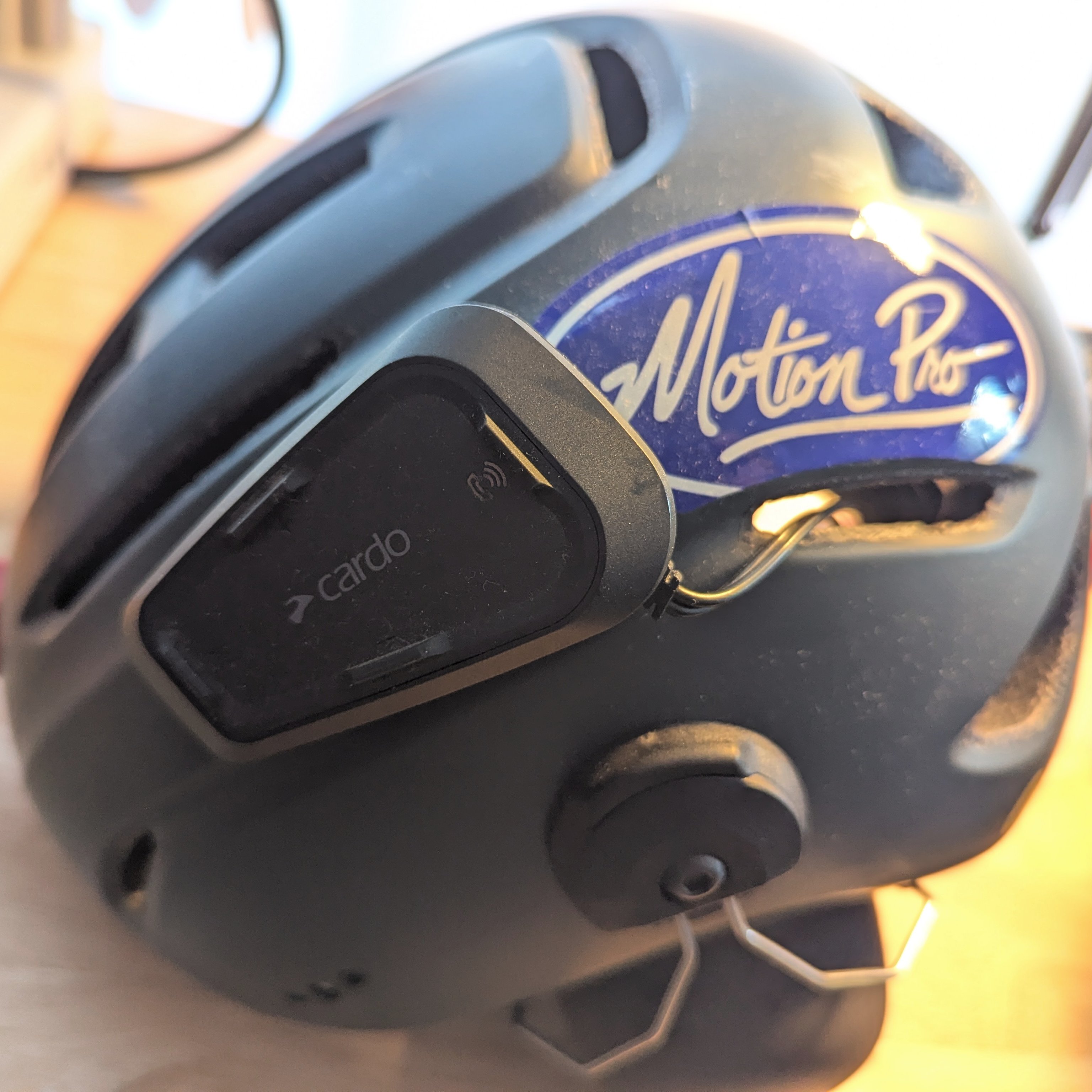

On the Cardo, I drilled a hole large enough for the mic to pass through and then hot-melt glued the base on the inside.
On the Sena, I drilled and riveted it. It is really important to use rivet backers (just small but correctly sized washers). Otherwise the rivets will just pull through the plastic ear cup.
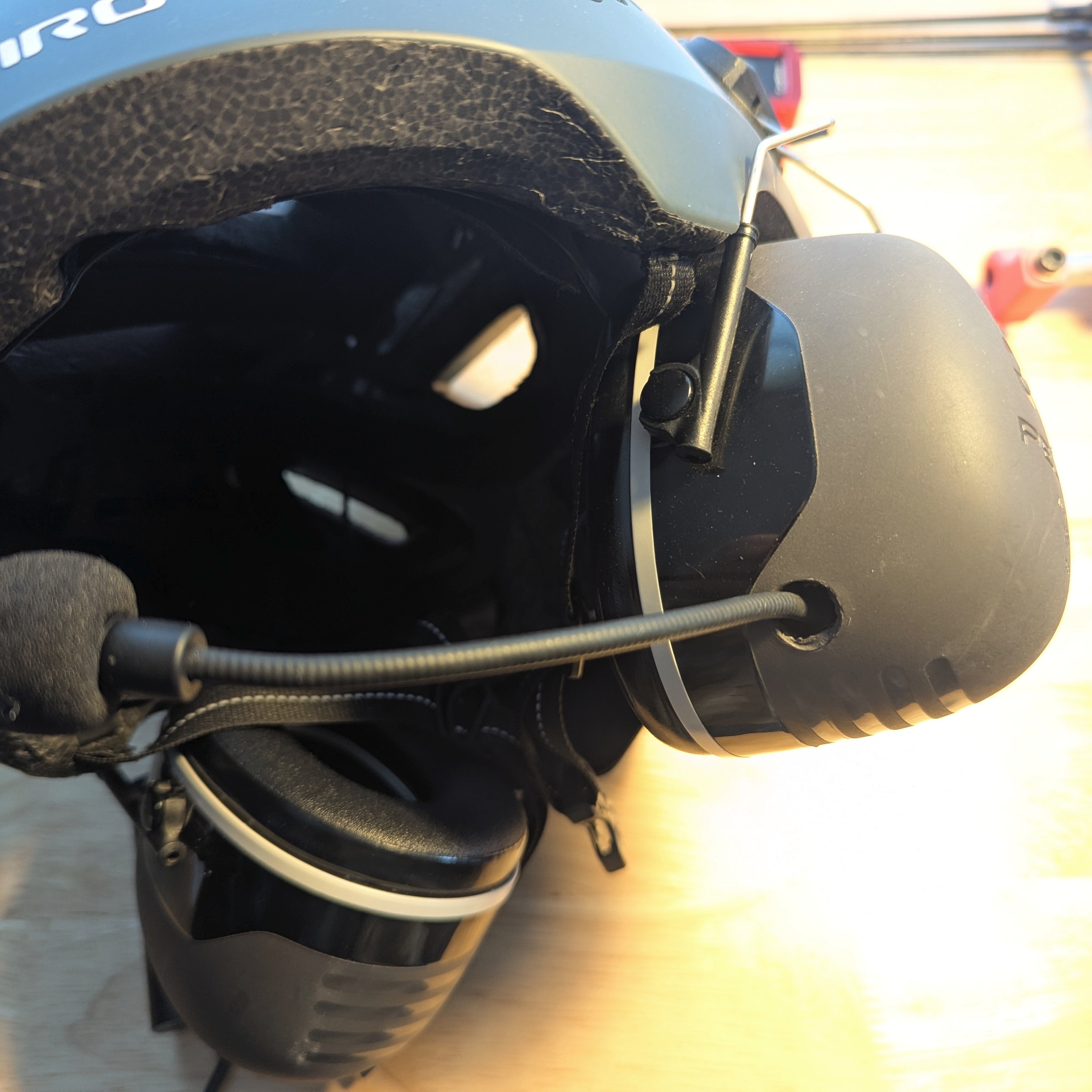
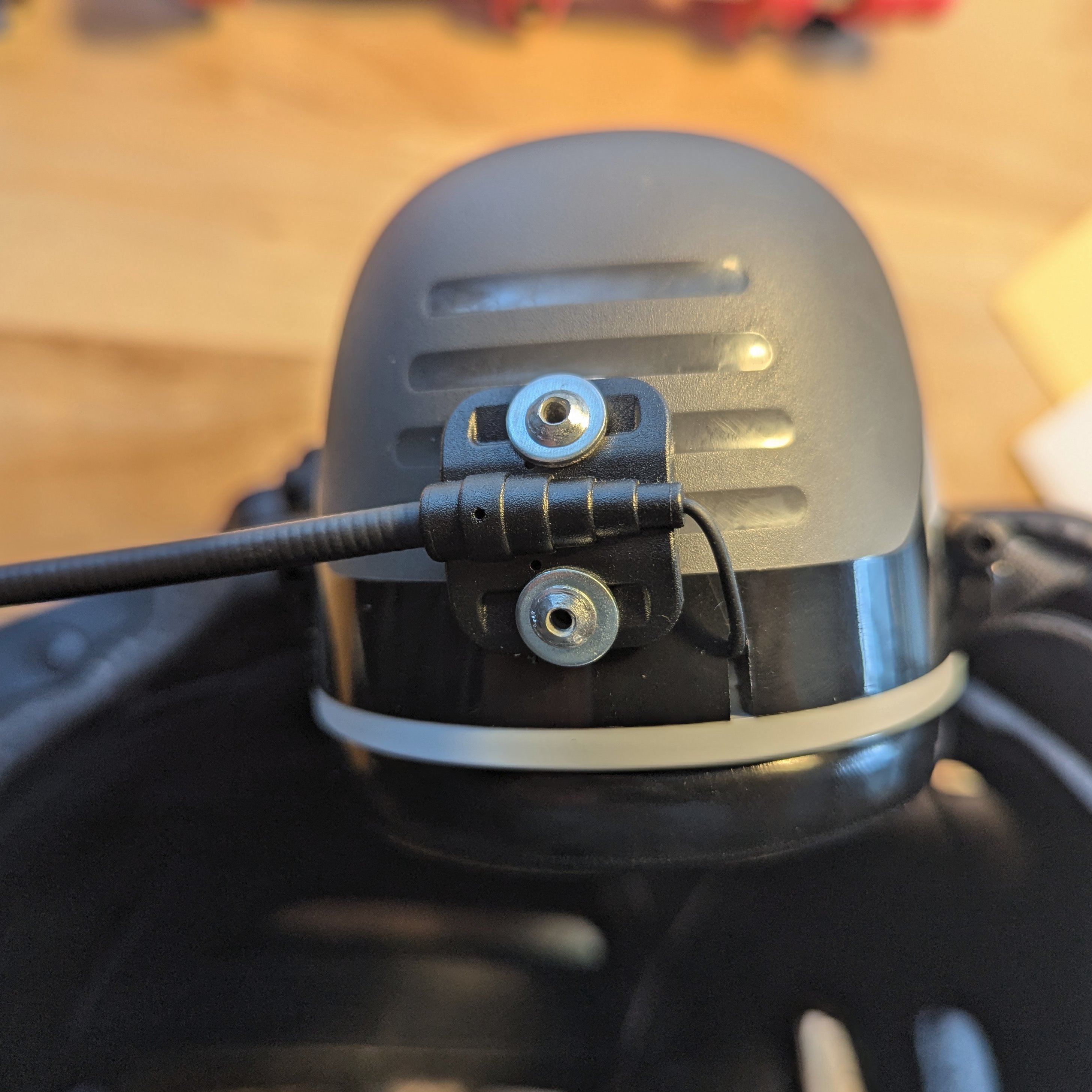
Phone Bluetooth Connection
Turn on the headset. Push the pairing button. Pair with the phone. Done. If you can not do this, you need to look at your life choices.
You will typically pair your phone with the headset as the primary phone.
Radio Bluetooth Connection
You will typically pair a radio with the headset as the secondary phone, or the GPS. If you want both the phone and the radio connected simultaneously, one has to be primary and one secondary.
That's the theory. In practice, what a nightmare!
Radios are almost all flawed when trying to connected a Bluetooth headset. I guess the developers never thought that we would want this. Everybody wants this!
The following few sections are hopefully helpful in specific Bluetooth connection options...
Sena 60S
We try to do everything all at once! You can not. I found the limit by connecting my phone as Primary, a radio as Secondary, connecting to my buddies using Mesh, and broadcasting all of that back to me with Sidetone turned on. Too much noise! And, the sidetone broadcast periodically stopped working in the right earcup (but everything else was fine) so, maybe a Sena firmware bug?
-
Turn Sidetone off. You know what you sound like.
-
Turn Background Sound to 100%. Otherwise, the radio volume (being a Secondary) is lowered behind the Mesh conversation (which is always on). I want to hear all radio calls!
Actually, I want the radio to interrupt everything else, but that is not an option with the Sena (it is with the Cardos: Settings -> Radio Integration -> On).
Icom A16B
Obviously read the manual for basic Bluetooth setup. However, everyone forgets the following:
- In the settings, you need to turn microphone source from Auto, the default, to Bluetooth.
When set to Auto it uses both the Bluetooth microphone AND the radio's internal microphone simultaneously. In other words, because the radio is mounted out in the breeze the internal microphone will pick up all of the wind and engine noise. That microphone needs to be disabled.
From my guess, the Icom A16B uses an older Bluetooth version. But it's aviation so it's garbage. It pairs pretty easily with my Cardo Spirit (their entry level model that's been around forever). And it pairs with my older generic Skull Candy headset. But trying to get it to work with the new Sena 60S?! Not easy.
The Icom A16B with the Sena 60S
The Icom A16B is a pain! If the Icom does not connect when it tries to, it goes into a Bluetooth failure and just gives up. You have to turn it off and on and try again. It would seem that the Icom is looking for Sena to broadcast that it is available, which it doesn't, and the Icom will not advertise that it is available. So they just sit there not connecting... until the Icom gives up and quits. I'm not picking on the Sena 60S, this problem may exist with many new headsets using the latest Bluetooth version.
Getting Connected...
-
The first is to have the Sena and your phone connected, and the radio off. Then turn off the Bluetooth on your phone. Then turn on your radio. The Sena freaking out looking for the phone then finds the Icom. Once connected, turn your phone's Bluetooth back on. Your phone reconnects. But the apps you had running on your phone are now all pissed off.
-
The second easier method. Turn on you radio first. The second it gets through its boot process, immediately turn on the Sena. It would seem they both start broadcasting availability once turned on, but only briefly. If you accidentally turn off your radio, turn the Sena off and start from scratch.
Staying Connected...
- You need to periodically use the Icom A16B! If you do not, after a while it will just display TIMEOUT on the screen and lock up (a wonderful undocumented feature). You then have to turn off the radio and start again.
Being Connected...
-
When you are on Mesh: Music from your phone, a phone call, calls from your aviation radio, etc. is played simultaneously with the Mesh conversation. Oddly, the Sena 60S does not give you the option to share this on Mesh. You can hear both, but others only hear you.
-
If you are on a phone call: The radio will not interrupt the call. (I wish it did.) *
-
If you are playing music on your phone: The radio will interrupt. But, music will not start automatically, you will have to hit play again. Annoying if you receive a lot of radio transmissions. *
* On the Cardo Spirit and Android it seems like: The radio will "ask" to interrupt. The phone app has a routine in it that pauses the phone call, lets the radio interrupt, then gets back to the call. Spotify (my music app) does not seem to have an "interrupt me" routine, it won't let go, so Cardo (and the Sena) simply disconnect the phone's Bluetooth connection. This definitely interrupts Spotify, which then pauses. When the radio is finished, the Bluetooth reconnects. But now you have to start deal with a pissed off Spotify app.
Recommendation - Use Something Else
If I knew then what I know now: I would not get the Icom A16B. It works great on the ground as a handheld, or if you do not mind spending too much money for an antiquated brand name radio, but the Bluetooth just does not work well and there are better alternatives.
If I knew then what I know now: I would not get the Sena. Trying to connect the Icom was disappointing, the Mesh works barely adequately, the Wave app is garbage. The only reason I have a Sena is because I followed my friends (and somehow I hear my mother saying "If your friends jumped off a bridge...").
Non-Aviation Radios (FMS / GMRS / Ham)
Lots of radio choices from Amazon. Whether its a Baofeng, Baofeng Tech (BTech), TIDRadio, Radiooddity, Midland, Retevis. These operate on bands other than Aviation. But because of this they are much cheaper!
The hard part is finding one:
- That has Bluetooth and will connect to a third-party Bluetooth headset.
- The ability to push the PTT button on the radio and then use the Bluetooth microphone.
- While using the Bluetooth microphone, the radio's microphone is disabled.
So far, the only one I know that works for sure (thank you Cardo YouTube videos) is the Oxbow Renegade X. The company is in Utah and they serve the extreme outdoor sports communities. It's a $180 FRS walkie talkie. Add a remote PTT button for $30. It would seem they have partnered with Cardo since you can buy bundles on their website.
Many of the cheaper radios do not connect to a Bluetooth headset. If they do, only the headset speakers work. Some require you to use VOX (not an option with a loud paramotor) or buy a separate button. It difficult to find one where you can simply push the radio's PTT and activate ONLY the Bluetooth microphone. I will keep looking!
Use A Separate Bluetooth Adapter!
I cannot believe that every radio does not already come with Bluetooth included. But they don't. So concede and just get a radio without Bluetooth. Then, there are adapters which plug into the radio's two pin connector and then create a Bluetooth connection. It will turn any radio into a Bluetooth radio.
-
To be sure it works it should have it's own PTT talk switch (this activates the PTT feature on the pins which activates the microphone on the pins). I have not tried, but I have seen the adapters from Pryme Radio Products. Expensive. Like more expensive than the radio. No thanks.
-
Alternatively you could just keep trying radio and adapter combinations until you find one that works. The issue is you do not know what action will happen when you press the radio's PTT with a headset connected. Sometimes only the headset microphone works (awesome), sometimes the internal microphone works (fail).
-
A Hack: Buy a dongle / earpiece combination and just do not use the earpiece. Bluetooth connect directly to your helmet! But this is a gamble... I do know that a $35 Bluetooth dongle / earpiece combination worked for my buddy's Wouxun radios, but did not with my TIDRadio radio. And a $60 Bluetooth dongle / earpiece / PTT combination did not work with anything (I return a lot of stuff to Amazon).
Acoustic Noise
Because they are designed for motorcycles, the microphones typically have some sort of noise canceling.
On most, including my Cardo, the microphone is actually two microphones. One points toward your mouth, the other faces outward (you can't tell, they are behind the foam). They both hear wind and engine noise, but one hears your voice more loudly. The microphone then simply subtracts what is common to both, leaving only your voice. It works fantastically. The downside is that it needs to be positioned correctly, or it doesn't work.
On my Sena, they apparently got tired of half-wits leaving bad reviews because the "microphone picks up all the noise" (yep, they couldn't figure out how to position it). So Sena went with a omni-directional mic (no noise canceling) and cancel noise using an algorithm in software. If the Sena hears the same sound for a while, it will just cancel it out. This doesn't work so well if you rev your engine. It take a second or so for the Sena to figure it out.
My solution was to simply make the microphone directional. I 3D printed a cover in the hopes it limits ambient noise.
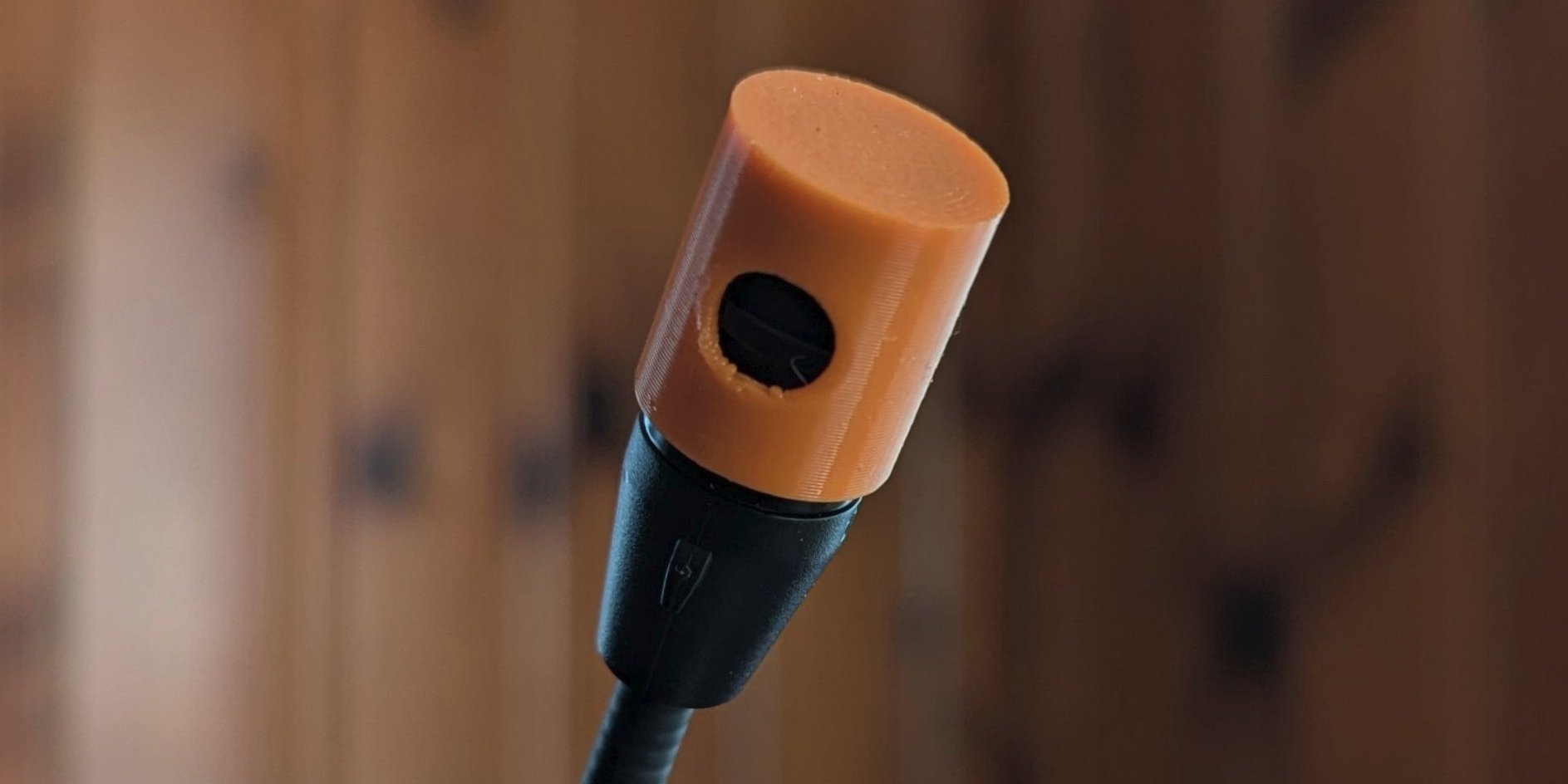
Radio Frequency (RF) Noise
To get an AM aviation radio to work well, you have to concern yourself with RF. With FM transmissions, not so much. But then again, aviation is not FM, it is garbage.
The biggest problem is the spark plug. So I shielded that. I took the spark plug boot off:
- Slide the boot up the wire.
- Remove the metal cap.
- Slide the boot off of the wire.
- It will require pliers!
With the boot off, I slid on a metal mesh shield. The edges were dressed with aluminum tape and zip ties. To ground it, I removed the rubber cover from the holding clamp (it's grabs the middle of the wire in the picture below). This clamp is mounted to the engine case just like the coil. Without a battery or some other large capacitor, this is as good as it gets.
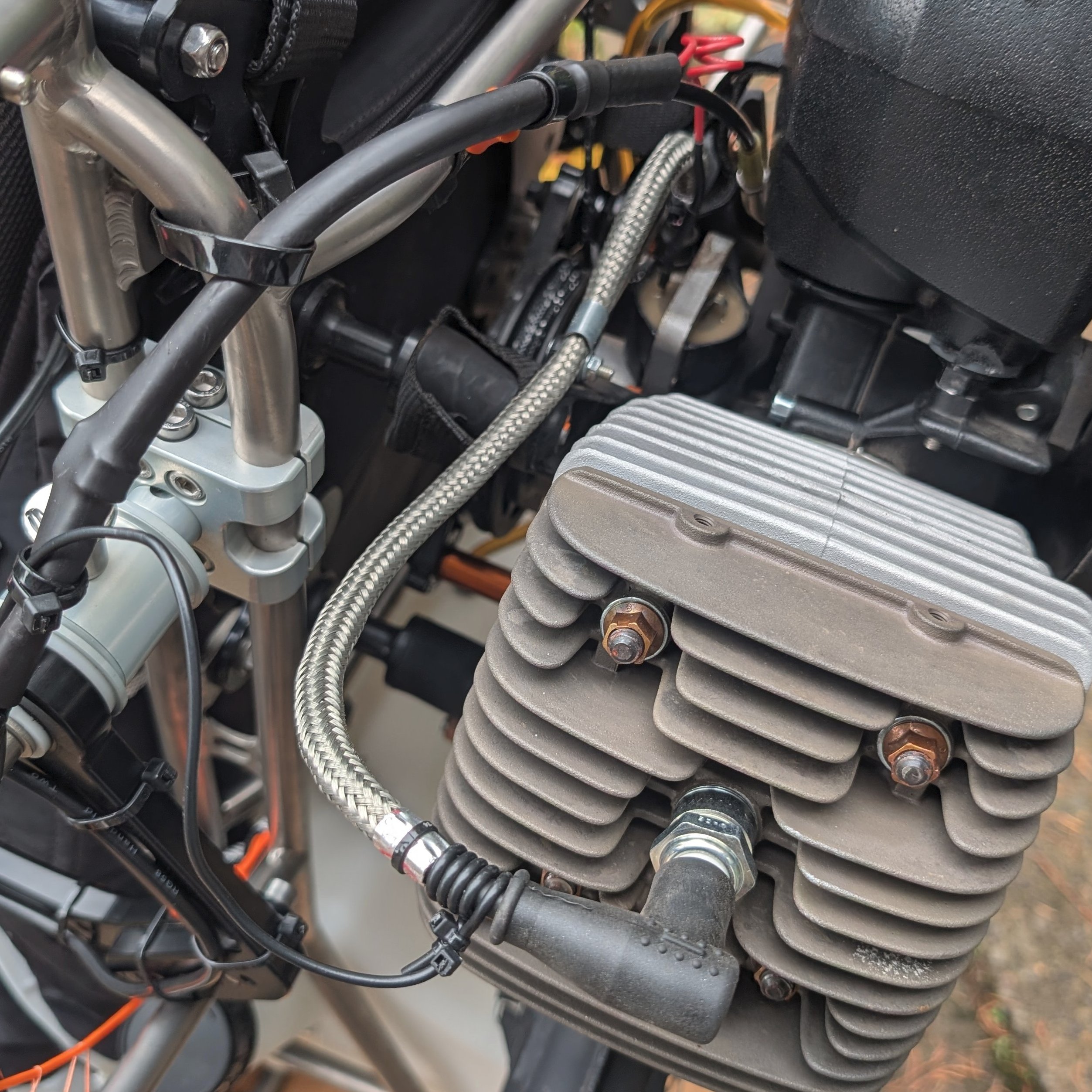
And, the tachometer uses an inductive pickup. It is basically the wire wrapped five or so times around the spark plug wire. This will not work wrapped around the shield. So scoot the shield back a bit and wrap the pickup around a little exposed wire. In the image above it is right next to the boot.
Not shown is my Stobe Wires. The stobes put out RF noise in the same fashion as the spark plug. But those I simply wired with shielded wire. Then grounded that to the strobe power source.
Optimizing the Antenna
I also remote mounted the antenna. It is not much further from the spark plug than it used to be, but at least it is oriented properly vertically.
One of the issues with connecting an antenna with coax is it needs a BalUn. From a current standpoint, the antenna is balanced (current flows equally in the element and the ground) and the coax is unbalanced (current only flows in the center element). If you don't stop it, the antenna will induce a current into the shield of the coax turning the coax into an antenna.
So you add ferrite cores to the outside of the coax next to the antenna. They suck up any skin effect (or whatever) current. I attached my Vector Network Analyzer (VNA) to the antenna. A Standing Wave Ratio (SWR) meter would work too. If you touch the coax with your hand and it changes the reading, the coax is an antenna. Add cores until this stops.
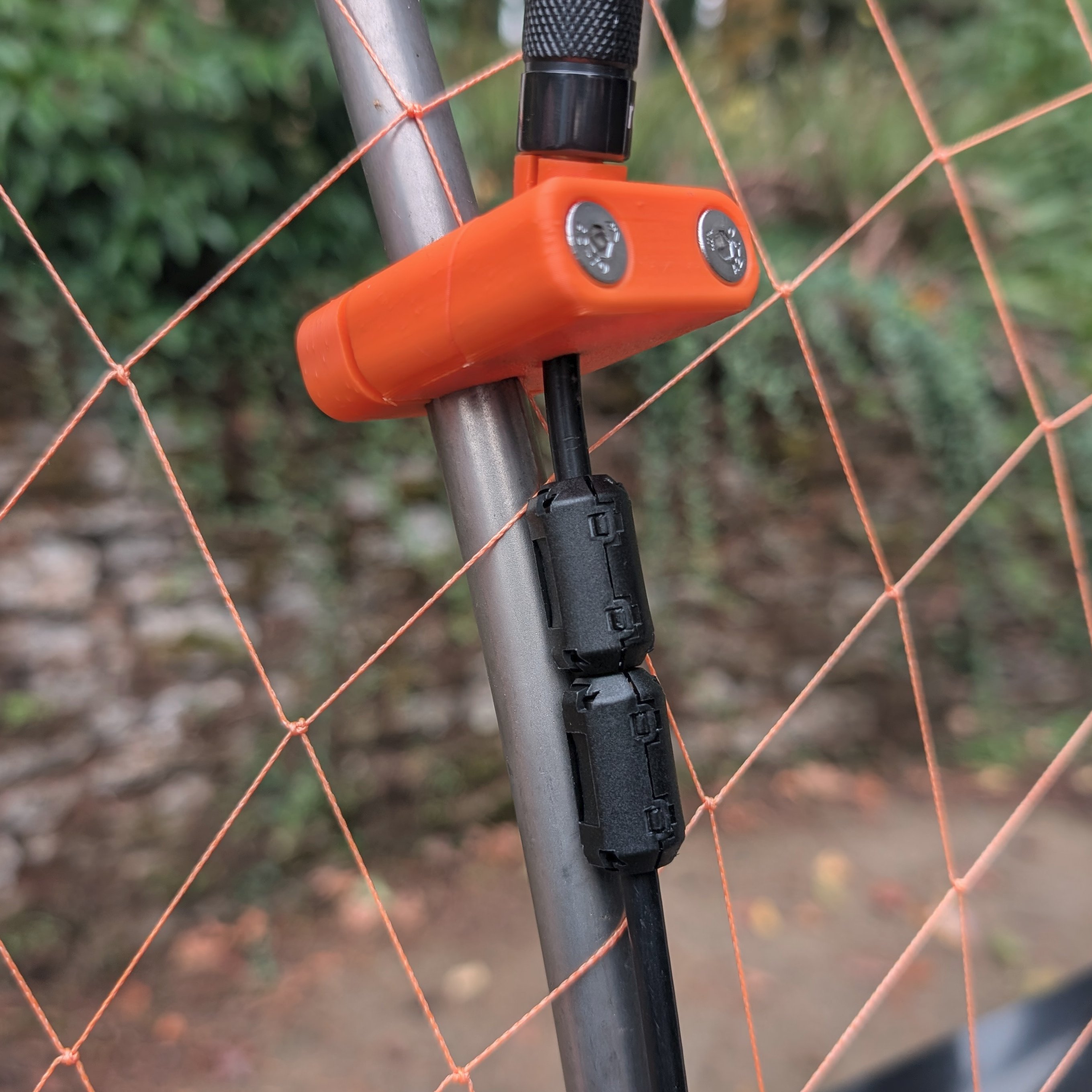
If you have any questions, just let me know:
https://worktablecnc.us/company/ontactcay.html